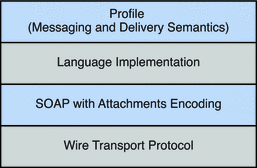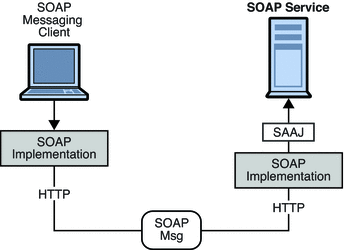SOAP with Attachments API for Java
The Soap with Attachments API for Java (SAAJ) is a JAVA-based API that enforces compliance to the SOAP standard. When you use this API to assemble and disassemble SOAP messages, it ensures the construction of syntactically correct SOAP messages. SAAJ also makes it possible to automate message processing when several applications need to handle different parts of a message before forwarding it to the next recipient.
Figure 5–1 shows the layers that can come into play in the implementation of SOAP messaging. This chapter focuses on the SOAP and language implementation layers.
Figure 5–1 SOAP Messaging Layers

The sections that follow describe each layer shown in the preceding figure in greater detail. The rest of this chapter focuses on the SOAP and language implementation layers.
The Transport Layer
Underlying any messaging system is the transport or wire protocol that governs the serialization of the message as it is sent across a wire and the interpretation of the message bits when it gets to the other side. Although SOAP messages can be sent using any number of protocols, the SOAP specification defines only the binding with HTTP. SOAP uses the HTTP request/response message model. It provides SOAP request parameters in an HTTP request and SOAP response parameters in an HTTP response. The HTTP binding has the advantage of allowing SOAP messages to go through firewalls.
The SOAP Layer
Above the transport layer is the SOAP layer. This layer, which is defined in the SOAP Specification, specifies the XML scheme used to identify the message parts: envelope, header, body, and attachments. All SOAP message parts and contents, except for the attachments, are written in XML. The following sample SOAP message shows how XML tags are used to define a SOAP message:
<SOAP-ENV:Envelope
xmlns:SOAP-ENV="http://schemas.xmlsoap.org/soap/envelope/"
SOAP-ENV:encodingStyle=
"http://schemas.xmlsoap.org/soap/encoding/">
<SOAP-ENV:Body>
<m:GetLastTradePrice xmlns:m="Some-URI">
<symbol>DIS</symbol>
</m:GetLastTradePrice>
</SOAP-ENV:Body>
</SOAP-ENV:Envelope>
|
The wire transport and SOAP layers are actually sufficient to do SOAP messaging. You could create an XML document that defines the message you want to send, and you could write HTTP commands to send the message from one side and to receive it on the other. In this case, the client is limited to sending synchronous messages to a specified URL. Unfortunately, the scope and reliability of this kind of messaging is severely restricted. To overcome these limitations, the provider and profile layers are added to SOAP messaging.
The Language Implementation Layer
A language implementation allows you to create XML messages that conform to SOAP, using API calls. For example, the SAAJ implementation of SOAP, allows a Java client to construct a SOAP message and all its parts as Java objects. The client would also use SAAJ to create a connection and use it to send the message. Likewise, a Web service written in Java could use the same implementation (SAAJ), or any other language implementation, to receive the message, to disassemble it, and to acknowledge its receipt.
The Profiles Layer
In addition to a language implementation, a SOAP implementation can offer services that relate to message delivery. These could include reliability, persistence, security, and administrative control, and are typically delivered by a SOAP messaging provider. These services will be provided for SOAP messaging by Message Queue in future releases.
Interoperability
Because SOAP providers must all construct and deconstruct messages as defined by the SOAP specification, clients and services using SOAP are interoperable. That is, as shown in Figure 5–2, the client and the service doing SOAP messaging do not need to be written in the same language nor do they need to use the same SOAP provider. It is only the packaging of the message that must be standard.
Figure 5–2 SOAP Interoperability

In order for a SAAJ client or service to interoperate with a service or client using a different implementation, the parties must agree on two things:
-
They must use the same transport bindings--that is, the same wire protocol.
-
They must use the same profile in constructing the SOAP message being sent.
- © 2010, Oracle Corporation and/or its affiliates
